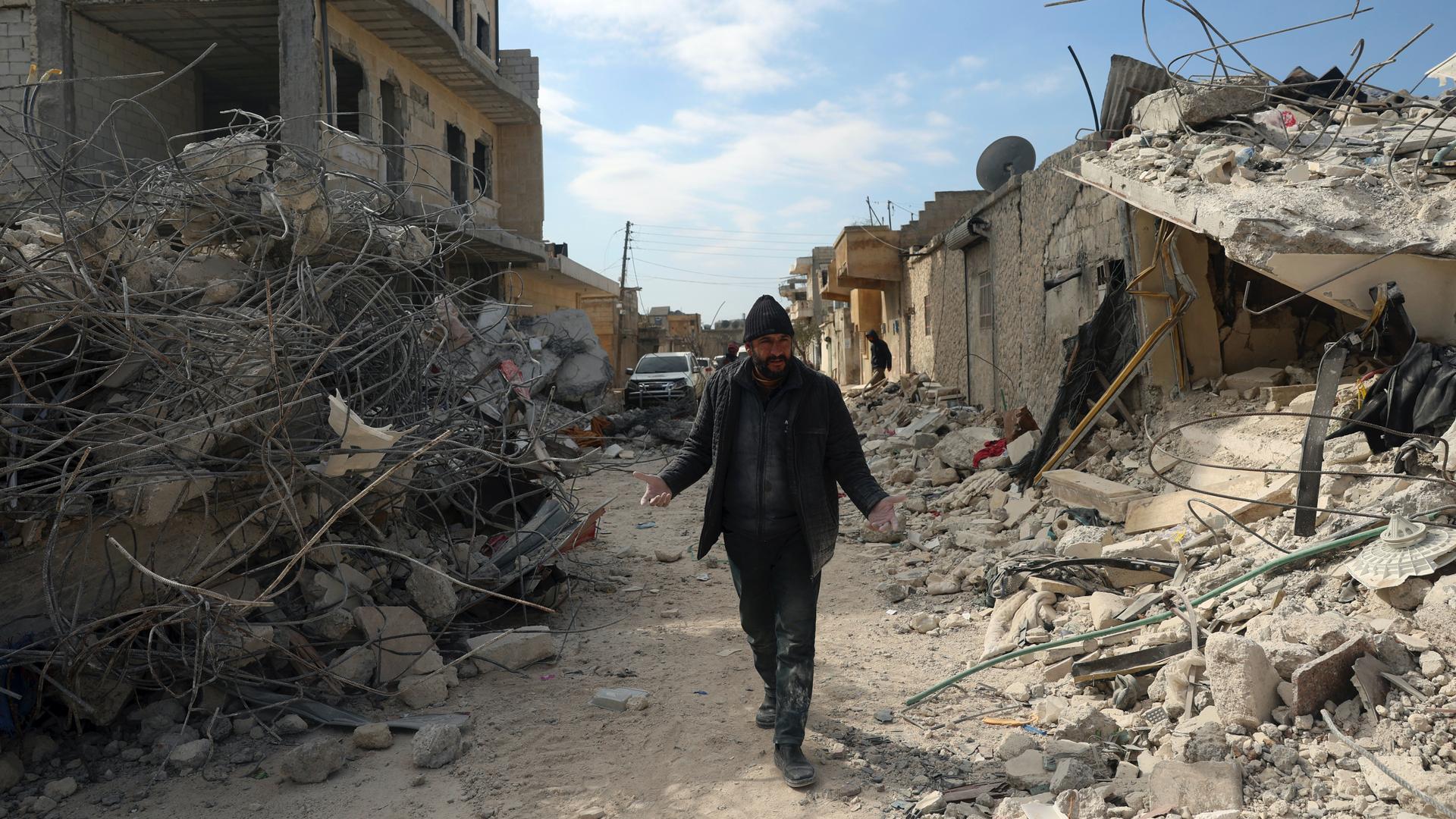A 27-year-old university student in Syria, who didn’t want to share his name for security reasons, said that there have been so many aftershocks over the past week that it’s hard to tell when the earth is shaking or if he’s imagining it.
“I keep a bottle of water next to me … or a small cup or whatever liquid based, just to make sure if I’m right or [not],” said the student, who lives in the port city of Latakia, which is controlled by the Syrian government.
The 7.4-magnitude quake left a lot of damage, he explained. Homes that are still standing are not safe to return to, so people are sleeping in mosques or churches. Help has been trickling in.
“There are so many [nongovernmental organizations] that are trying to help; other than NGOs, there are individuals who are making so much effort to give the people what they need,” he said.
How fast and how much Syrians have received aid following the earthquake depends on where people live. The response has highlighted that there really are two Syrias: one under the government’s control, where international relief organizations are helping out. Another, the opposition-controlled northwest, mostly isolated from the rest of the world.
On Sunday, the US ambassador to the UN, Linda Thomas-Greenfield, urged the security council to open another border crossing from Turkey into northwest Syria.
But Russia, an ally of Syria’s government, has veto power on the council. And so far, the Kremlin has said that one border crossing into Syria is enough.
The UN said on Monday that Syrian President Bashar al-Assad has agreed to open two crossing points from Turkey to northwest Syria for an initial period of three months “to allow for the timely delivery of humanitarian aid.”
Warm food, baby formula, diapers and clothes are some of the items being shipped to Latakia. Most are coming from the capital, Damascus.
That’s where Charlotte Streinger, a French teacher, has been organizing donation drives.
“I teamed up with three of my colleagues from the school. Spontaneously, we created this team, and we started gathering trustful contacts throughout the country with people that we know,” she said.
Streinger started an online fundraiser and she said in just three days, she managed to raise about $7,500.
“But the problem is that as with everything that is linked to Syria, it was then blocked,” she added.
Syria is under strict economic sanctions. Last Thursday, the US Treasury made a temporary exemption for aid related to the earthquake. Yet, the sanctions are still being felt on the ground.
Streinger said she could have used the money to buy things such as food, hygiene products and blankets, some of the most-needed items. Instead, she said, she is left with no cash and having to apologize to those who donated. She is trying to find a way to return their money.
“It made me feel horrible. Horrible,” she said.
The Syrian city of Aleppo — also under government control — was heavily damaged in the earthquake. Over the weekend, the head of the World Health Organization, Tedros Ghebreyesus, visited the city.
“We have just come today with supplies and look forward to continuing to support,” he told reporters.
Ghebreyesus came with a planeload of medical supplies. A second one is scheduled this week, WHO said.
Aleppo saw widespread destruction during Syria’s civil war, and filmmaker Youssef Saba said the earthquake “finished the job.”
In a series of WhatsApp messages, he explained that help is beginning to pour into Aleppo, some coming from inside Syria, and some from outside.
Aleppo even got the attention of the Syrian president himself.
Bashar al-Assad and his wife, Asma al-Assad, visited a hospital on Friday. It was all smiles and hugs in videos shared online. But for Syrians living in areas not under government control, things have been very different.
The northwest province of Idlib was hit hardest by the earthquake and more than a week later, people there said they still don’t have the equipment needed to pull victims from under the rubble.
“We want the UN to apologize. They’re making the people of … the Syrian people disappointed,” Raed al-Saleh, head of the White Helmets, told reporters last Friday.
Martin Griffiths, the UN’s emergency relief coordinator, tweeted as much on Sunday.
“We have failed people in northwest Syria,” he wrote, adding that “my duty and our obligation is to correct this failure as fast as we can.”
Karam Kellieh, a photographer working in the northwest part of the country, said that people have lost hope of rescuing victims trapped under the rubble and that those who survived have no shelter.
“People [were] refugees before the earthquake. Now, they’re [living] in the roads, in hospitals, in schools,” he said.
Some have camped under olive trees and have been spending nights in the frigid temperatures.
“No picture of video can explain what happened in north of Syria,” Kellieh said.
The World is an independent newsroom. We’re not funded by billionaires; instead, we rely on readers and listeners like you. As a listener, you’re a crucial part of our team and our global community. Your support is vital to running our nonprofit newsroom, and we can’t do this work without you. Will you support The World with a gift today? Donations made between now and Dec. 31 will be matched 1:1. Thanks for investing in our work!
